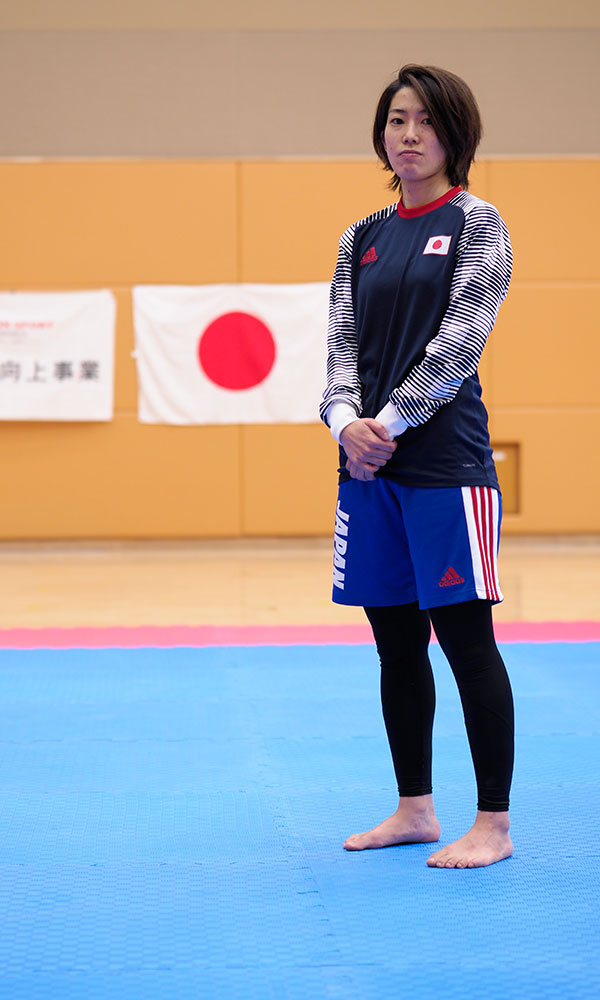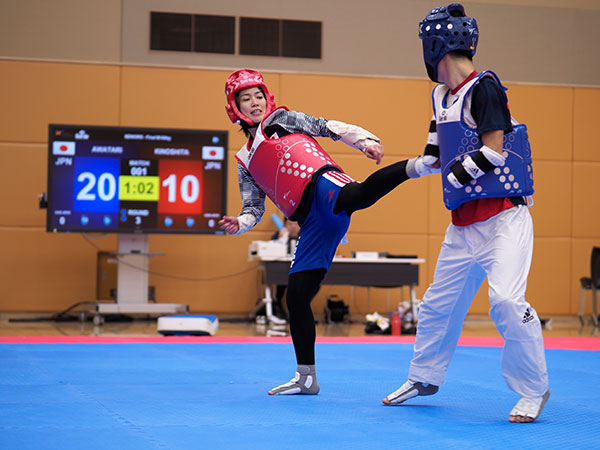A young kinesiologist in love with the front roundhouse kick

Research, education and legacies related to the sporting event
The Olympic and Paralympic Games will be held in Tokyo for the first time in more than half a century. The University of Tokyo, which is also located in the metropolis, has a long history of involvement with the Games. As you learn about UTokyo’s contributions to this global sporting event, the blue used in the Olympic and Paralympic emblem may very well start to take on the light blue hue of the University’s school color.
| Kinesiology |
A young kinesiologist in love with the front roundhouse kick
Vying for a medal in Para Taekwondo

At a training gym for All Japan Taekwondo Association-certified athletes in November 2019. Photo: Takumi Inoue
During her studies at Osaka University, Research Associate Madoka Kinoshita was introduced to taekwondo, devoted herself to the art, earned Japan’s highest student taekwondo ranking, and went on to finish second in the All-Japan Championships, which also allows working adults to participate. Although she came close to gaining a position on the Japanese team that went to the London Olympics, she continued her graduate school education at University of Tsukuba, and focused her research there on the quantitative analysis of the speed of the front roundhouse kick — one of her favorite moves.
“I had been told my kick was slow but after properly measuring it, I discovered that it was actually fast. With fake moves and other ways of hiding kick attacks, I learned about the importance of giving opponents visual impressions of speed.”
Kinoshita currently works as a research associate in UTokyo’s Sports Science Laboratory, engaging in biomechanics research, and conducting classes in physical education. She is also active as the chair and a coach at the All-Japan Taekwondo Association (AJTA)’s Para Taekwondo Committee. Para Taekwondo will be an official Olympic sport for the first time at the upcoming Tokyo Games, and is for taekwondo athletes with deformities or disabilities in their upper limbs. Bouts consist of three 2-minute rounds, and the fighter that achieves the highest number of effective kicks to their opponent’s torso wins the round. When a fighter unleashes a kick timed to a vocalized “R” and strikes their opponent, the impact emits a heavy, deep sound, and has enough power to leave viewers concerned about the damage it might do should it land on an upper extremity with a disability, regardless of the protective equipment the fighters wear.
“Although I had been involved in taekwondo, I knew absolutely nothing about para taekwondo, and was left in awe of when I saw it in person for the first time at the Asian Para Taekwondo Championships in 2016. As a researcher engaged in biomechanics, I could almost feel the pain from the intense kicks that fighters without arms were delivering just as well as fighters without any disabilities. Although I’ve had my own regrets as a fighter, I was determined to devote myself in spreading the appeal of this sport.”
That said, as only a handful of taekwondo association staff are responsible for para taekwondo-related matters, Kinoshita practically has to do everything by herself, from gathering information from the World Taekwondo (WT) and participating organizations in other countries to translating sporting rules and regulations, searching for sponsors, finding new fighters with talent, developing spaces for taekwondo practice, and arranging medical support. Of course, serving as sparring partners for AJTA-certified fighters and developing strategies to win are also among the important duties of the association members.
“Electronic protective gear was adopted starting with the London Olympics in 2012, and enlists sensors to automatically determine whether a kick is legitimate or not. This system has several quirks that allow points to be influenced by the type of kick or where it strikes. Japanese taekwondo athletes tend to be at a disadvantage relative to their foreign opponents in terms of physique or bodily strength. Hence, we would like to harness as a weapon any technique that makes this electronic gear an ally.”
At the Tokyo Games, male and female para taekwondo fighters alike will be grouped into six divisions by weight, with 12 individuals assigned to each weight division. As the host nation, Japan is to be awarded a quota that qualifies its team to compete in three divisions. At the February 2019 World Para Taekwondo Championships in Turkey, Shunsuke Kudo and Shoko Ota won the bronze medals in the men’s under 75-kg and women’s over 58-kg divisions, respectively. This has lifted expectations.

“The outcome of the Tokyo Games will have a major impact on the future of this sport. I absolutely want them to win a medal in at least one of those three weight divisions and ensure our team a position at the 2024 Games in Paris,” exclaims Kinoshita, underlining her fervent hopes as the chair of the Para Taekwondo Committee. What then about her prospects as a researcher?
“For instance, para taekwondo fighters might be described as members of a new human sub-species that have evolved the ability to effectively compensate for disabilities in their upper extremities with their entire bodies and deliver powerful kicks. Humans have the potential to evolve in diverse ways other than just in their upper limbs. I would like to identify correlations between modifications of movement and variations in the physique of athletes with disabilities, and on that basis explore models of the human species in its final form.”

* This article was originally printed in Tansei 40 (Japanese language only). All information in this article is as of March 2020.






